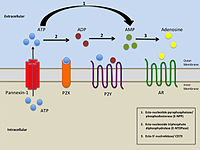
Photo from wikipedia
Abstract The oxygen reduction (ORR) is one of the most essential electrochemical reactions for the development of promising energy storage and conservation technologies such as metal-air batteries and fuel cells.… Click to show full abstract
Abstract The oxygen reduction (ORR) is one of the most essential electrochemical reactions for the development of promising energy storage and conservation technologies such as metal-air batteries and fuel cells. The slow kinetics of oxygen reactions; however, limits the use of metal-air batteries and fuel cells in demanding applications. The aim of this study is to investigate the electrochemical activity of Ag-based oxides, Ag2XO4 (where X = Cr, Mo, and W), to be used as a catalyst material in these applications. In this regard, precipitation and/or hydrothermal methods were used to synthesize powders without impurities. Structural characterizations were performed by SEM and XRD prior to use of synthesized powders. Then, linear sweep voltammograms of catalysts loaded rotating disk electrode and gas diffusion layer were investigated via a three-electrode cell in 0.1 M and 6 M KOH electrolyte, respectively. The most promising results were obtained from Ag2WO4 powders. The onset and half-wave potentials of the ORR for the Ag2WO4 catalyst were 930 mV and 710 mV RHE, respectively. Moreover, the electron transfer number, Tafel slope, limiting current density and overpotential at −3 mA cm−2 current density for Ag2WO4 were 3.8, 47, 5 mA cmgeo−2 and 540 mV, respectively. The results presented revealed that the hydrothermally synthesized Ag2WO4 might be a possible ORR catalyst. The stability of Ag2WO4 was verified by chronoamperometry and accelerated durability tests. Synthesized powders were compared with the commercially purchased 67 wt% Pt/C and synthesized α-MnO2 powders which having proven activity for ORR.
Journal Title: Journal of Solid State Chemistry
Year Published: 2020
Link to full text (if available)
Share on Social Media: Sign Up to like & get
recommendations!